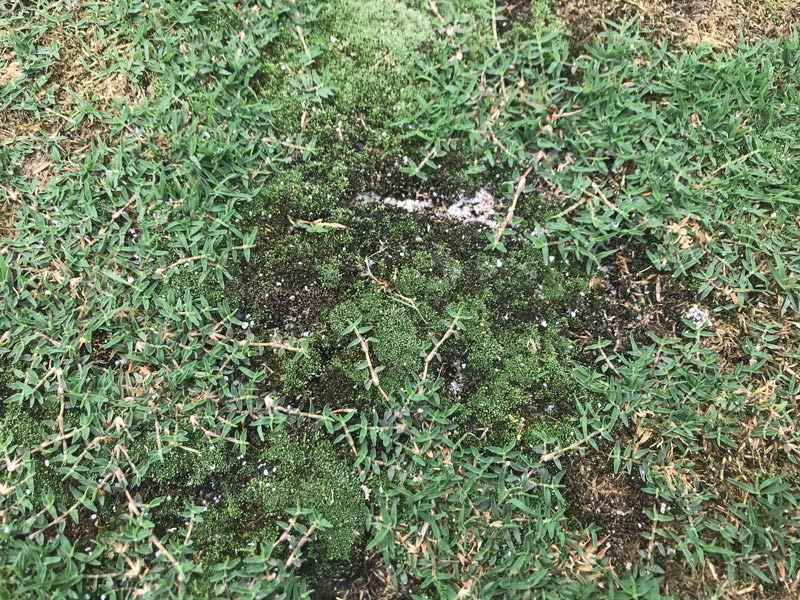
Figure 1. Thinning turf, particularly of warm-season grasses such as hybrid bermudagrass (TifEagle is shown here), during spring green-up has been reported from repeated use of copper- and zinc-containing products. Photos courtesy of Adam Gore
Products such as fertilizer, fungicide, colorant and algaecide are commonly applied to help maintain aesthetically pleasing and healthy turf during various times of the calendar year. Heavy metals such as copper (Cu) and zinc (Zn) serve as key components in many of these products, and, in minute amounts, these nutrients serve as essential nutrients for plant function. In healthy turf, concentrations range from 5 to 20 ppm for copper and 20 to 55 ppm for zinc (4). Sufficient levels of these micronutrients are found in many soils throughout the United States, but these elements are less soluble — and thus less available — in soils with higher (>7) pH values (5).
Copper is considered an essential micronutrient because of its role in oxidation-reduction processes, and because it serves as a component in photosynthetic electron transport, cell-wall metabolism and hormone signaling (7). However, because of the potential for redox cycling between divalent (Cu2+) and monovalent forms (Cu+), copper can increase the production of hydroxyl radicals within a plant, leading to decreased vigor or death at high concentrations (2).
Products containing copper sulfate are often used to treat for algae development in water sources, including those used for irrigation, and as corrective measures for sandy, acidic greens where copper deficiency is more likely to be observed (3). In a study published in 1980, decreased vegetative growth of Poa annua and Agrostis palustris caused by copper toxicity was correlated to soil pH, with more acidic soils yielding significantly less growth because more copper is available at lower soil pH (6).
Zinc is an immobile micronutrient used in enzyme activation, chlorophyll formation and hormone regulation, as well as in seed formation and cell growth. Toxic levels of zinc are commonly found in soil contaminated by mining and smelting activities, but also in soils treated with sewage sludge (1). Zinc applications are typically made only when symptoms of deficiency appear, but some new colorants on the market that contain zinc in the form of zinc oxide (ZnO) are labeled for multiple applications.
Hybrid bermudagrass such as TifEagle, Champion and MiniVerde (Cynodon dactylon (L.) Pers. × C. transvaalensis Burtt-Davy) and zoysiagrass such as Diamond (Zoysia matrella (L.) Merr.) are used on golf course greens in the southeastern U.S. because they are able to withstand low mowing heights and the heat and humidity associated with the area’s climate. Zoysiagrass use is increasing on sites that receive less than eight hours of sunlight, which would cause suboptimal growth in bermudagrass greens (5).
There has been an increase in reports of thinning turf, predominately in spring-transitioning warm-season grasses, with the prolonged use of products containing copper and zinc (Figure 1, above). The purpose of this study was to evaluate the tolerance of two warm-season turfgrasses exposed to varying levels of copper and zinc concentrations through foliar applications to create an initial tolerance baseline.
Methods
Individual greenhouse trials were conducted at Clemson University in Clemson, S.C., using TifEagle hybrid bermudagrass and Diamond zoysiagrass plugs growing in a 100% sand mixture in 6-inch (15-centimeter) pots during 2018 and 2019. Results of the studies were consistent, and only those from the first year will be discussed.
Plugs were allowed four weeks for rooting and grow-in prior to study commencement. In a rate response trial, foliar applications of copper (copper sulfate, pentahydrate, LabChem, Zelienople, Pa.) and zinc (zinc sulfate, heptahydrate, LabChem, Zelienople, Pa.) were applied weekly on each grass species at concentrations of 0, 250, 500, 1,000 and 2,000 ppm of each metal over a nine-week period. Pots were treated separately and received supplemental irrigation to maintain field capacity.
To assess reaction to foliar applications, measurements of visual turf quality, normalized difference vegetation index (NDVI, data not shown) and phytotoxicity were recorded weekly. Visual turf quality was measured on a 1-9 scale, with 9 representing full, green color and healthy turf, and 1 representing complete plant death. A visual turf quality rating of 7 was considered acceptable by industry standards. Phytotoxicity was measured on a 0%-100% scale, with 100% representing complete browning or dead turf.
At the conclusion of each study, plant tissue was collected and submitted to the Clemson University Agricultural Service Lab for analysis of heavy metal concentrations.
Results: Zinc
Bermudagrass

Figure 2. Visual turf quality of TifEagle bermudagrass in response to foliar applications of zinc in 2018 greenhouse trials at Clemson University, Clemson, S.C. DAIT, days after initial treatment. Different letters within a date represent significant differences among treatments. NS, no significant difference.
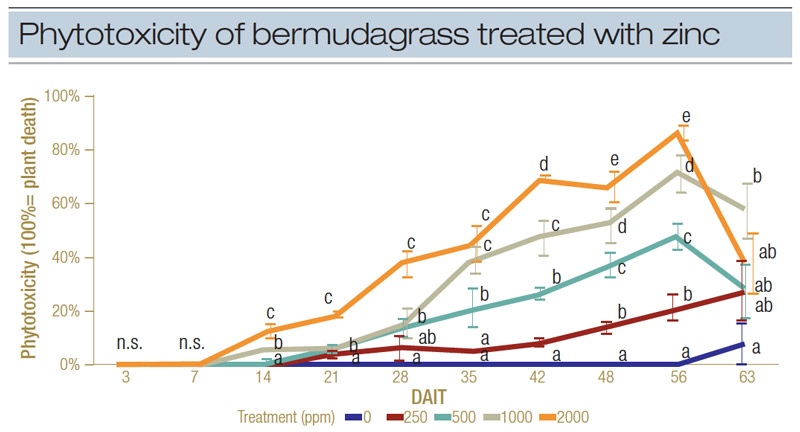
Figure 3. Phytotoxicity of TifEagle bermudagrass in response to foliar applications of zinc in 2018 greenhouse trials at Clemson University, Clemson, S.C. Different letters within a date represent significant differences among treatments. NS, no significant difference.
In all studies, increased concentrations of zinc caused a significant decrease in visual turf quality as well as a significant increase in turfgrass phytotoxicity. On TifEagle bermudagrass, significant differences in visual turf quality and phytotoxicity were observed between 0 and 2,000 ppm beginning 14 days after initial treatment (DAIT) (Figures 2, 3, above). By 28 DAIT, treatments consisting of 500, 1,000 and 2,000 ppm were unacceptable. At 63 DAIT, only the untreated grass represented acceptable turf quality (≥7).
Zoysiagrass
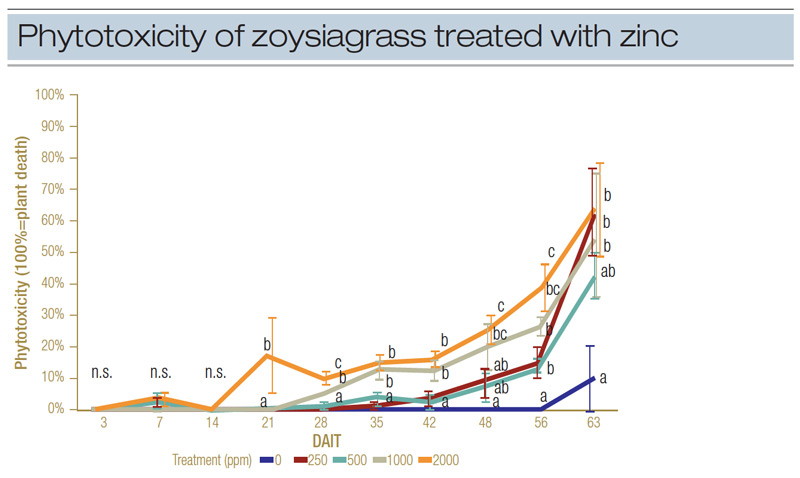
Figure 4. Phytotoxicity of Diamond zoysiagrass in response to foliar applications of zinc in 2018 greenhouse trials at Clemson University, Clemson, S.C. Different letters within a date represent significant differences among treatments. NS, no significant difference.
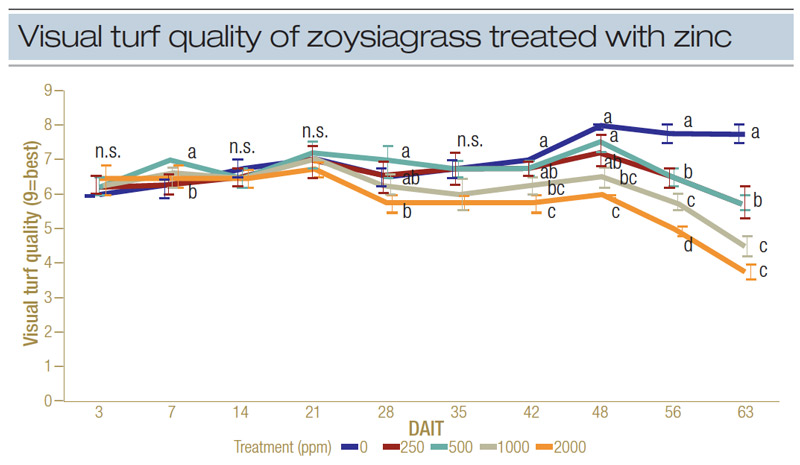
Figure 5. Visual turf quality of Diamond zoysiagrass in response to foliar applications of zinc in 2018 greenhouse trials at Clemson University, Clemson, S.C. Different letters within a date represent significant differences among treatments. NS, no significant difference.
In all studies, increased concentrations of zinc caused a significant decrease in visual turf quality as well as a significant increase in turf phytotoxicity. On Diamond zoysiagrass, significant differences in phytotoxicity were observed between 0 and 2,000 ppm beginning 21 DAIT (Figure 4, above), with differences between 0 and 2,000 ppm in visual turf quality beginning 28 DAIT (Figure 5, above). At 63 DAIT, only the untreated grass represented acceptable turf quality (≥7).
Results: Copper
Bermudagrass
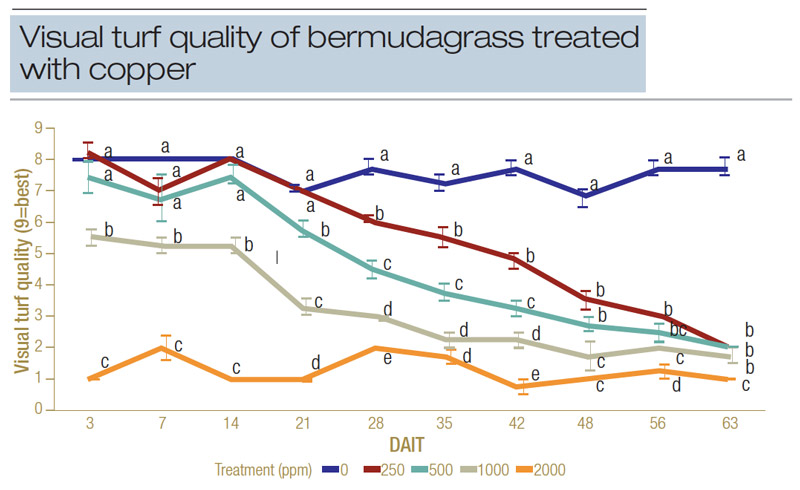
Figure 6. Visual turf quality of TifEagle bermudagrass in response to copper applications in 2018 greenhouse trials at Clemson University, Clemson, S.C. Different letters within a date represent significant differences among treatments. NS, no significant difference.
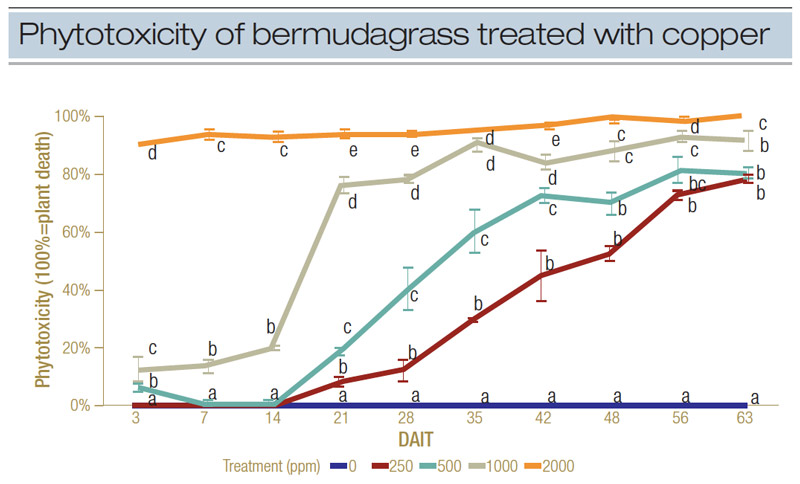
Figure 7. Phytotoxicity of TifEagle bermudagrass in response to copper applications in 2018 greenhouse trials at Clemson University, Clemson, S.C. Different letters within a date represent significant differences among treatments. NS, no significant difference.
On TifEagle bermudagrass, differences in visual turf quality and phytotoxicity were observed between 0 and 2,000 ppm beginning 3 DAIT (Figures 6, 7, above). All treatments except for 0 ppm were less than acceptable (<7) by 28 DAIT. By 63 DAIT, all concentrations produced visual turf quality less than 3 and a phytotoxicity average of ~0.7, whereas untreated grass remained above the acceptable level of 7 (Figure 8, below).
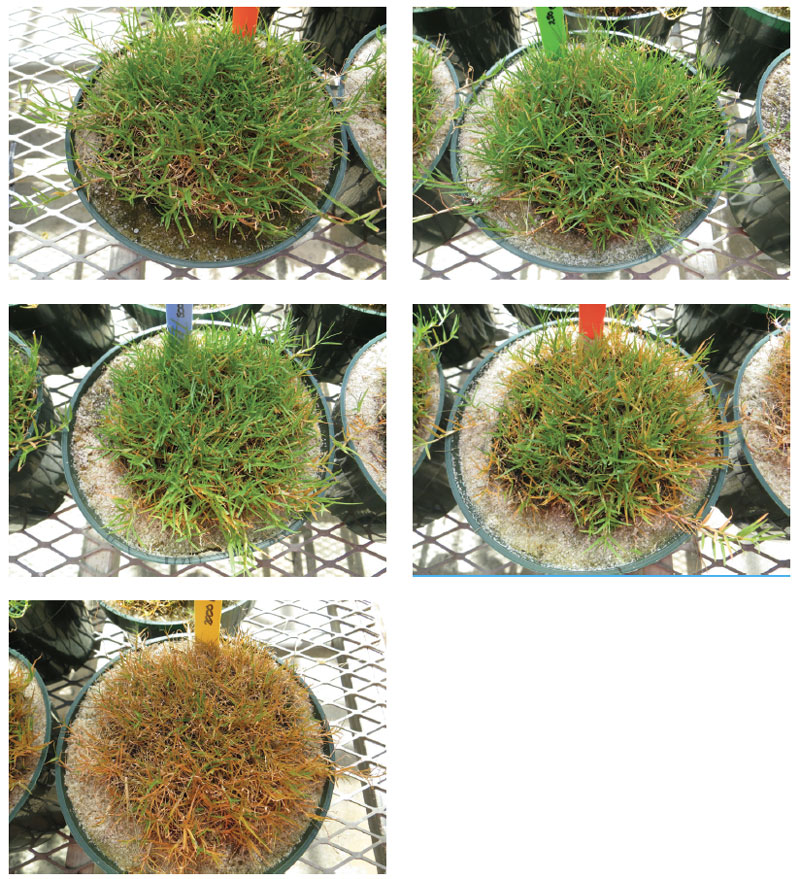
Figure 8. TifEagle bermudagrass treated with varying concentrations of copper, three days after initial treatment. Top row: untreated (left) and 250 ppm. Middle row: 500 ppm (left) and 1,000 ppm. Bottom row: 2,000 ppm.
Zoysiagrass
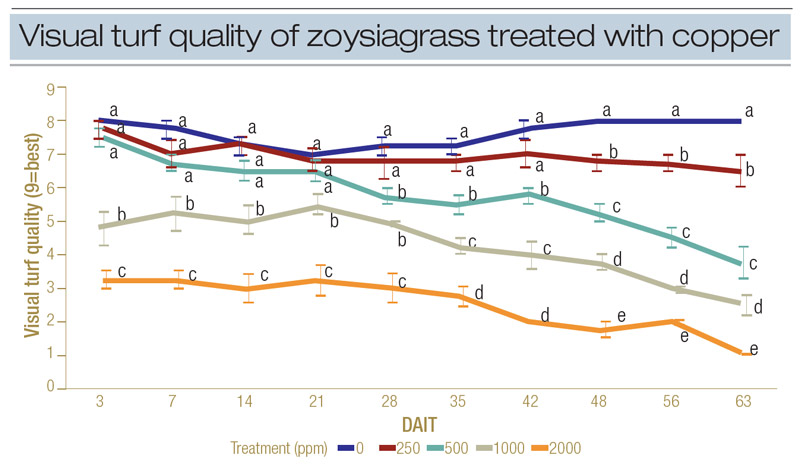
Figure 9. Visual turf quality of Diamond zoysiagrass in response to copper applications in 2018 greenhouse trials at Clemson University, Clemson, S.C. Different letters within a date represent significant differences among treatments. NS, no significant difference.
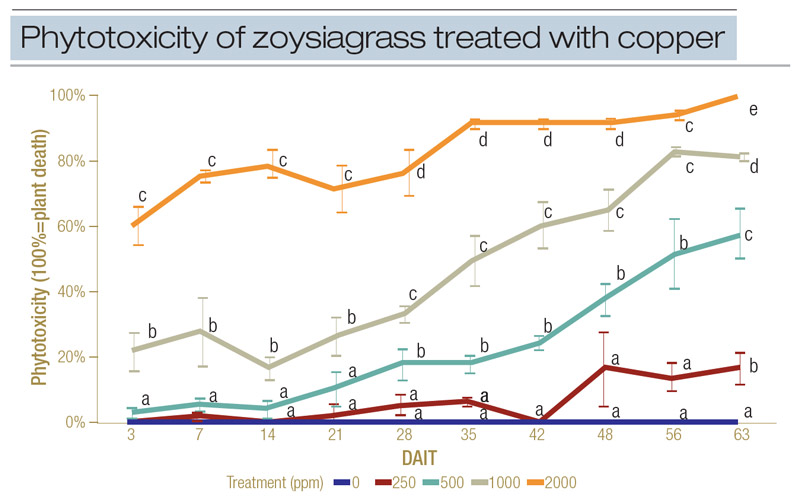
Figure 10. Phytotoxicity of Diamond zoysiagrass in response to copper applications in 2018 greenhouse trials at Clemson University, Clemson, S.C. Different letters within a date represent significant differences among treatments. NS, no significant difference.
For zoysiagrass, increased concentrations of copper caused a significant decrease in visual turf quality as well as a significant increase in phytotoxicity. Differences in visual turf quality and increased phytotoxicity between 0 and 2,000 ppm were noted beginning 3 DAIT (Figures 9, 10, above). Treatments of >500 ppm produced visual turf quality below 7 by 21 DAIT, with 250 ppm having an unacceptable level at 48 DAIT. At 63 DAIT, only the untreated grass had acceptable visual turf quality.
Results: Tissue analysis
In turfgrass leaf tissue, optimal levels of zinc range from 20 to 55 ppm, and optimal levels of copper range from 5 to 20 ppm (4). Concentrations of zinc and copper in plant tissues were analyzed in greenhouse studies, but because the treatments had suppressed plant growth, analysis of individual replications was replaced by analysis of combined replications. Analyzing combined replications negated statistical comparisons; therefore, the data can only be observed.
All values exceeded the optimal levels in turfgrass. For example, for the 2,000 ppm zinc treatment, foliar zinc levels ranged from over 5,000 ppm in bermudagrass samples to over 15,000 ppm in zoysiagrass samples. Pots treated with 2,000 ppm copper exhibited over 11,000 ppm and 20,000 ppm in zoysiagrass and bermudagrass, respectively. In zoysiagrass, pots treated with 250 ppm of copper produced tissue concentrations of 384 ppm, and treatments with zinc 2,651 ppm. Treating hybrid bermudagrass with copper at 250 ppm resulted in tissue concentrations of 601 ppm, and treatments with zinc at 250 ppm resulted in tissue concentrations of 2,067 ppm. At even the lowest treatment levels, toxicity traits eventually occurred after repeat applications.
Conclusion
Diamond zoysiagrass and TifEagle bermudagrass were initially able to tolerate applications containing high concentrations of zinc. However, repeat applications eventually led to decline in turf quality in both species, though zoysiagrass appeared more tolerant. Both grass species reacted more quickly to copper applications, with the highest copper concentrations causing decline in both species in as little as three days after initial treatment. With copper-containing products being heavily used to treat algae in irrigation water, and with copper present in some fungicides as well as various pigments, colorants and dyes, this study emphasizes the importance of applying products in accordance with label rates and timings.
Though these rates are abnormally high for what would typically be expected in field conditions, this does provide a baseline for expected decline and interaction of warm-season turfgrasses in response to heavy metal presence.
Further research is needed to determine field grass response to applied products typically associated with turf management, with studies currently underway at Clemson University.
Funding
This research was funded by Bert McCarty’s research lab.
The research says ...
- Repeat applications containing elevated levels (≥250 ppm) of copper and zinc can lead to gradual and/or rapid decline of the warm-season grasses hybrid bermudagrass and zoysiagrass.
- Zoysiagrass appears more tolerant to these heavy metals, but repeat applications can eventually damage it.
- Increased sensitivity of hybrid bermudagrass and zoysiagrass to copper warrants the monitoring of irrigation water quality for heavy metals.
Literature cited
- Broadley, M.R., P.J. White, J.P. Hammond, I. Zelko and A. Lux. 2007. Zinc in plants. New Phytologist 173(4):677-702 (https://doi.org/10.1111/j.1469-8137.2007.01996.x).
- Halliwell, B., and J.M.C. Gutteridge. 1984. Oxygen toxicity, oxygen radicals, transition metals and disease. The Biochemical Journal 219:1-14 (https://doi.org/10.1042/bj2190001).
- Hull, R.J. 2002. Copper management demands attention. Golfdom 58(7):T12-T16.
- Jones Jr., J.R. 1980. Turf analysis. Golf Course Management 48(1):29-32.
- McCarty, L.B. 2018. Golf turf management. CRC Press, Boca Raton, Fla.
- Riemer, D.N., and H.L. Motto. 1980. Tolerance of two grass species to copper-treated irrigation water. Journal of Aquatic Plant Management 18:3-6 (http://www.apms.org/wp/wp-content/uploads/2012/10/v18p3.pdf).
- Yruela, I. 2005. Copper in plants. Brazilian Journal of Plant Physiology 17(1):145-156 (http://dx.doi.org/10.1590/S1677-04202005000100012).
Adam Gore is an ag/hort Extension agent and a member of the horticulture program team at Clemson Extension’s Abbeville County Cooperative Extension Office in Abbeville, S.C., and a doctoral student at Clemson University, Clemson, S.C. Bert McCarty is a professor of horticulture specializing in turfgrass science at Clemson University. Philip Brown is an Extension specialist in soil science and septic education in the School of Plant and Environmental Sciences at Virginia Tech, Blacksburg, Va.